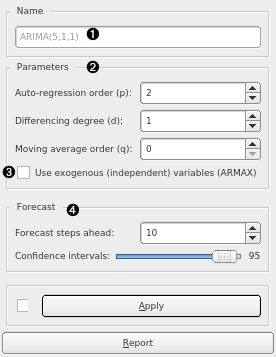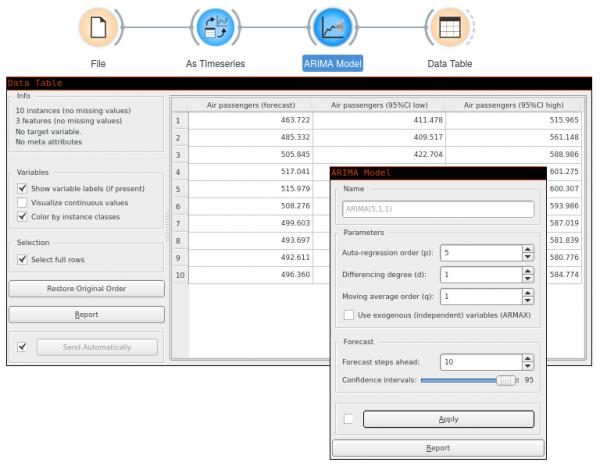Difference between revisions of "Orange: ARIMA Model"
Jump to navigation
Jump to search
Onnowpurbo (talk | contribs) (Created page with "Sumber: https://orange.biolab.si/widget-catalog/time-series/arima/ Model the time series using ARMA, ARIMA, or ARIMAX model. Inputs Time series: Time series as output...") |
Onnowpurbo (talk | contribs) |
||
| (4 intermediate revisions by the same user not shown) | |||
| Line 2: | Line 2: | ||
| − | Model | + | Widget ARIMA Model me-model-kan time series menggunakan model ARMA, ARIMA, atau ARIMAX. |
| − | + | ==Input== | |
| − | + | Time series: Time series as output by As Timeseries widget. | |
| − | + | Exogenous data: Time series of additional independent variables that can be used in an ARIMAX model. | |
| − | + | ==Output== | |
| − | + | Time series model: The ARIMA model fitted to input time series. | |
| − | + | Forecast: The forecast time series. | |
| − | + | Fitted values: The values that the model was actually fitted to, equals to original values - residuals. | |
| − | + | Residuals: The errors the model made at each step. | |
| − | + | Menggunakan widget ARIMA Model, kita dapat me-model time series menggunakan model ARIMA. | |
| − | + | [[File:Arima-model-stamped.png|center|400px|thumb]] | |
| − | |||
| − | |||
| − | |||
| − | + | * Model’s name. By default, the name is derived from the model and its parameters. | |
| + | * ARIMA’s p, d, q parameters. | ||
| + | * Use exogenous data. Using this option, you need to connect additional series on the Exogenous data input signal. | ||
| + | * Number of forecast steps the model should output, along with the desired confidence intervals values at each step. | ||
| − | See also | + | ==Contoh== |
| + | |||
| + | [[File:Arima-model-ex1.png|center|600px|thumb]] | ||
| + | |||
| + | |||
| + | ==See also== | ||
VAR Model, Model Evaluation | VAR Model, Model Evaluation | ||
| + | ==Youtube== | ||
| + | |||
| + | * [https://www.youtube.com/watch?v=szLbgFRRl18 YOUTUBE: Forecast Time Series] | ||
==Referensi== | ==Referensi== | ||
Latest revision as of 04:54, 9 April 2020
Sumber: https://orange.biolab.si/widget-catalog/time-series/arima/
Widget ARIMA Model me-model-kan time series menggunakan model ARMA, ARIMA, atau ARIMAX.
Input
Time series: Time series as output by As Timeseries widget. Exogenous data: Time series of additional independent variables that can be used in an ARIMAX model.
Output
Time series model: The ARIMA model fitted to input time series. Forecast: The forecast time series. Fitted values: The values that the model was actually fitted to, equals to original values - residuals. Residuals: The errors the model made at each step.
Menggunakan widget ARIMA Model, kita dapat me-model time series menggunakan model ARIMA.
- Model’s name. By default, the name is derived from the model and its parameters.
- ARIMA’s p, d, q parameters.
- Use exogenous data. Using this option, you need to connect additional series on the Exogenous data input signal.
- Number of forecast steps the model should output, along with the desired confidence intervals values at each step.
Contoh
See also
VAR Model, Model Evaluation

